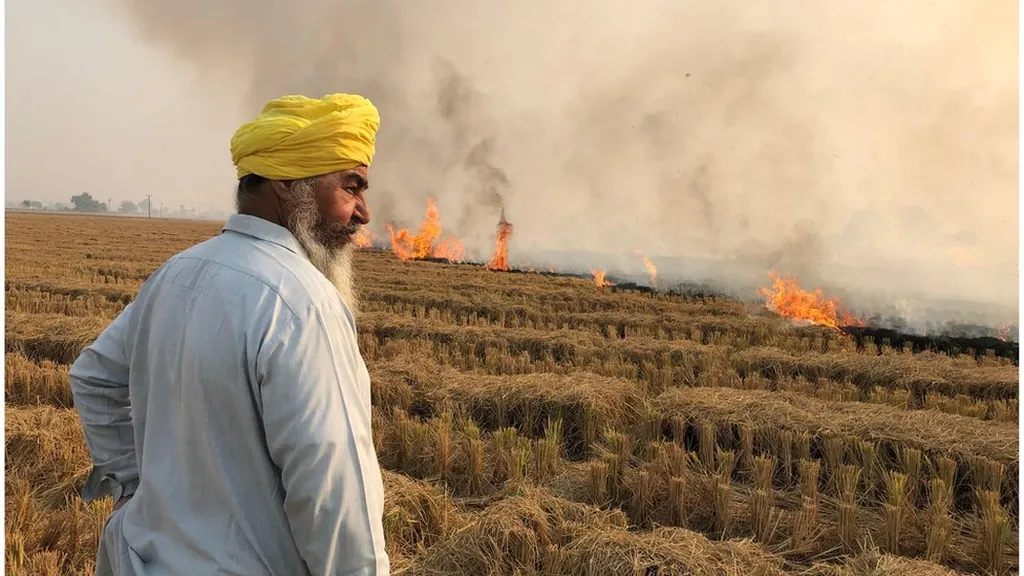As North India continues to grapple with winter smog, a significant portion of which is attributed to stubble burning, a novel rice farming technology offers a potential solution. Straw Traktor, a machine developed by London-headquartered agritech company Straw Innovations, transforms leftover paddy straw into biochar and renewable energy, enhances soil health, and even opens the possibility of a third rice harvest each year. The company plans to bring this technology to India next year through a partnership with Innovate UK, UKAid, and Earthshot Prize winner, Takachar, a Delhi-based clean-tech start-up.
The announcement comes at a critical time for India, the world’s second-largest rice producer. The country is facing mounting pressure from extreme weather, with unseasonal rains, flooding, and declining soil fertility already eroding farm incomes. The burning of crop residue continues to choke northern states every winter, exacerbating air pollution and contributing to methane emissions.
India produces nearly 140 million tonnes of paddy annually, generating around 90 million tonnes of crop residue. Much of this stubble is still burnt in open fields, significantly contributing to air pollution and methane emissions. According to experts, Straw Traktor could complement India’s push for low-carbon farming and provide a commercial alternative to residue burning. By turning straw into energy and soil nutrients, it promises economic value for what was previously a liability.
Vidyut Mohan, Co-founder and CEO of Takachar, highlighted the potential of Straw Innovations’ equipment. “Straw Innovations’ equipment like the Straw Traktor solves a universally prevailing pain point in rice straw collection and reduces the number of steps and, hence, overall cost for a farmer to do so. This will help scale up value creation from this biomass through decentralised opportunities, like biochar production. This will in return lead to an increase in rural livelihoods and crop yields and prevent methane emissions.”
Craig Jamieson, Founder and Director of Straw Innovations, underscored that this new system brings together world-leading technologies and business models for the first time to set a new benchmark for rice processing globally. “For rice-producing communities and the environment, it’s nothing short of transformational,” he said.
The Straw Traktor, unveiled recently at the Rice Straw Bioenergy Hub in Pila, Laguna, Philippines, is designed specifically for wet and flooded fields, where conventional harvesters struggle. It collects straw from paddies, rotavates the soil, and spreads biochar, allowing farmers to add another crop cycle and increase total output by up to 65%, according to the company. By processing straw, instead of burning or leaving it to decompose, the system also halves methane emissions from rice cultivation—a greenhouse gas over 80 times more potent than CO₂. For smallholders, it creates additional income by converting agricultural residue into saleable products such as compost, fuel, and soil amendments.
Straw Innovations’ circular farming model links the machine with energy-efficient rice milling by Koolmill Systems and Takachar’s biochar technology. The integrated model is backed by Innovate UK and UKAid, with research support from Aston University and the Southeast Asian Regional Center for Graduate Study and Research in Agriculture (SEARCA).
Mercedita Sombilla, a leading global agricultural economist and Director of SEARCA, said, “The development of rice straw management solutions will not only contribute to the reduction of greenhouse gas emissions but also enable communities to turn agricultural wastes into livelihood opportunities that increase incomes.”
India is set to benefit from this UK-driven rice innovation that can unlock a third harvest and turn crop residue into clean energy, highlighting deepening UK–India cooperation in climate-smart farming.
The UK- and Philippines-based agritech firm plans to introduce the Straw Traktor in India in 2026 as part of the Energy Catalyst programme. Given that 90% of the world’s rice is cultivated in Asia and demand is expected to rise along with population growth, India’s adoption of such technologies may lead the way for regional change by aligning food security goals with its climate commitments.
Notably, the Philippine Department of Agriculture has already signalled interest in integrating the model into its national programmes. Agnes Catherine Miranda, Director of the Department of Agriculture’s Climate Resilient Agriculture Office in the Philippines, said that the innovation could help integrate rice straw solutions into local programmes and pilots, supporting productivity, cutting emissions, and improving rural livelihoods. Researchers from SEARCA and Aston University are currently studying its socio-economic and environmental impacts to assess scalability across Asia.
On the ground, early adopters say the benefits are tangible. Leonard Lospe Jr., a farmer involved in the project, said, “What Straw Innovations has done is a huge help—not only are they a business, but they are truly helping the farmers. Not just for us, but we are also able

